| 1 | The most advanced sea snake |
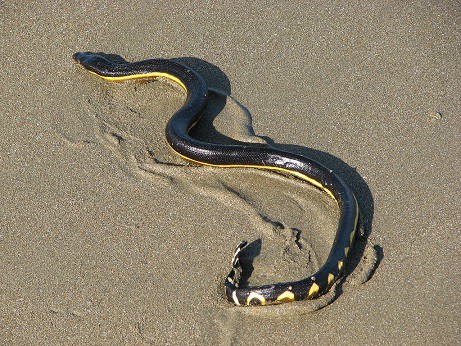
The true sea snakes reside exclusively in the Pacific and Indian oceans, and are believed to have evolved only recently, diverging from venomous Australian snakes just 10 million years ago. In that time, one species has evolved further than all – the yellow-bellied sea snake. This has the most massive empire of any sea-faring serpent, stretching from South Africa in the extreme west, all the way to the Costa Rican and Panamanian coastlines. Inbetween, they’re abundant around Australia, Indonesia and their neighbours.
Unlike the banded sea krait, which rests on rocky shores in order to digest food, this is a species of the true open seas. Yellow-bellied sea snakes typically live miles off shore, or even in the remote hearts of oceans, whether a stormy sea of crashing waves, or the blue, sparkling seas of a postcard. They possess the usual salt gland in their skull, which absorbs and expels salinity in sea water before dehydration reaches fatal levels.
Yellow-bellied sea snakes can go 7 months without drinking in their open sea habitats. The main time people see them is after accidentally washing up on beaches, being dragged around by sudden ocean currents. This snake almost never appears in estuaries or muddy tidal flats, and even coral reefs are a rarity.
| 2 | Washes up in remote places |
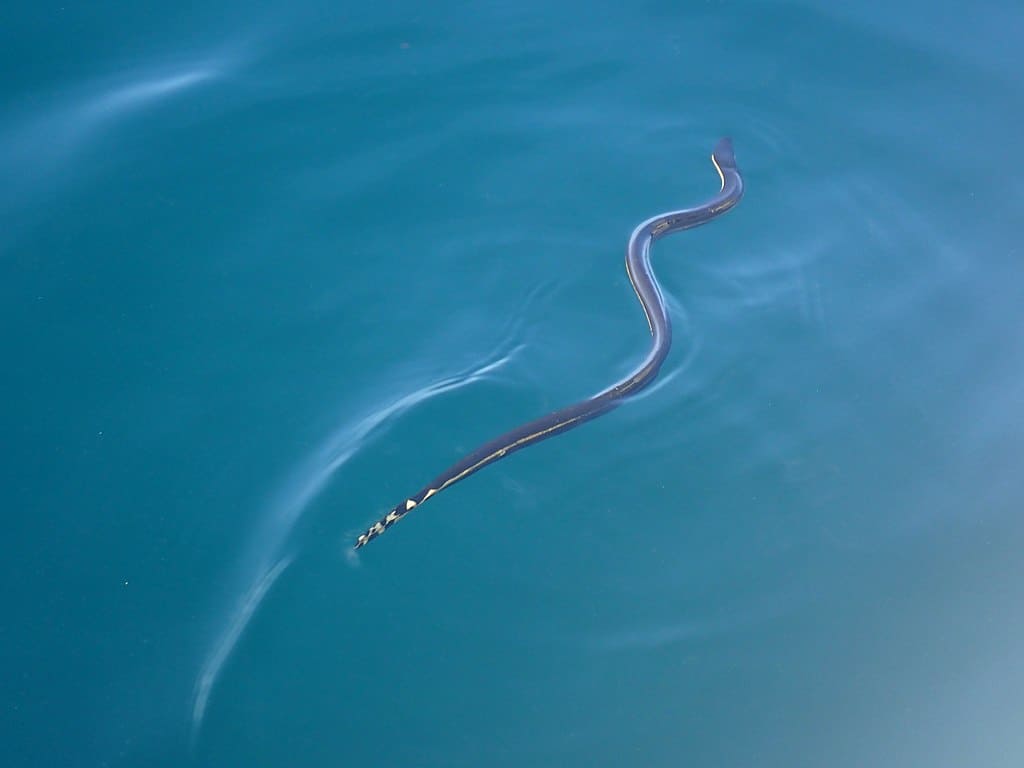
Hydrophis platurus is the boldest and most adventurous of all sea snakes. Case in point: they’re the only species to have been found in California, which is normally devoid of sea snakes. A recent case happened in October 2015, when a yellow-bellied sea snake was spotted by a surfer on Silverstrand Beach. This was the northernmost sighting ever, and the first ever record in Ventura County. Beachgoers felt a spike of fear, while scientists felt a jolt of excitement. Ripped from its ocean domain and stranded on the shore, the snake died rapidly. Prior to 2015, only 3 yellow-bellied sea snakes had ever been observed in California, the previous sighting being in 1972 when a snake washed up at San Clemente.
The El Nino phenomenon was blamed, an upswelling of warm water in the mid-latitude Pacific ocean, which meant that the coast of California was unusually comfortable for them. Yellow-bellied sea snakes are quite a relaxed snake, and are commonly found drifting aimlessly with sea currents, regularly landing them in strange places.
Yellow-bellied sea snakes are terrible at moving on land. They have sharply keeled belly scales which dig in and bog them down, and they struggle even to stay upright. Yellow-bellies that wash up on beaches usually fail to last long.
| 3 | Occasionally found in New Zealand |
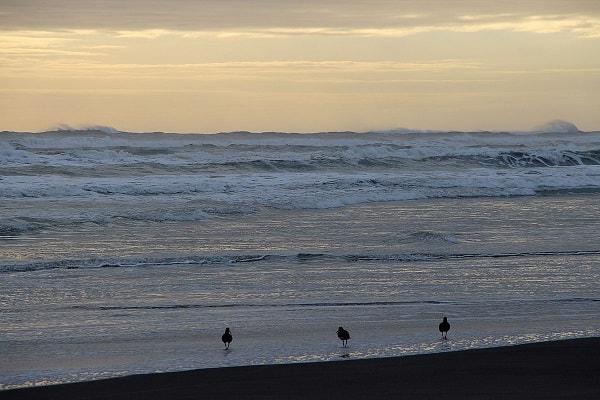
New Zealand is another outpost for yellow-bellied sea snakes. The land of Kiwis has no official native snake species, but 5-10 yellow-bellies wash up on the northern shores each years. Rogue ocean currents are to blame, as the 15-20C waters are too cold for them, but a recent case happened in December 2022, on an unidentified beach.
“What have we found, bro? Don’t know if it’s an eel or a snake,” said one man as he lifted its tail with a stick. Suddenly, the snake started writhing, causing the fear quotient of the crowd to spike. The yellow and black colours were unmistakable for anyone even with a basic snake handbook. Earlier in 2022, a man was arrested after finding a yellow-bellied sea snake on Tangimoana Beach in Manawatū, and failing to return it to the sea. Instead, he poked it with a stick.
Sea snakes of the Aipysurus family can be hard to identify, but nobody with even cursory knowledge could fail to identify the yellow-bellied sea snake. The clues are there, as its back is a dense black, while its underside is a vivid banana yellow. The black and yellow are simple blocks of colours with no patterns overlaying each. This is a medium sized snake. Females are longer at an average of 88cm, with males averaging at 72cm. Up to 114cm has been recorded. This species weaves through the ocean with a paddle-shaped tail, which swishes water effortlessly from side to side.
| 4 | Millions at once |
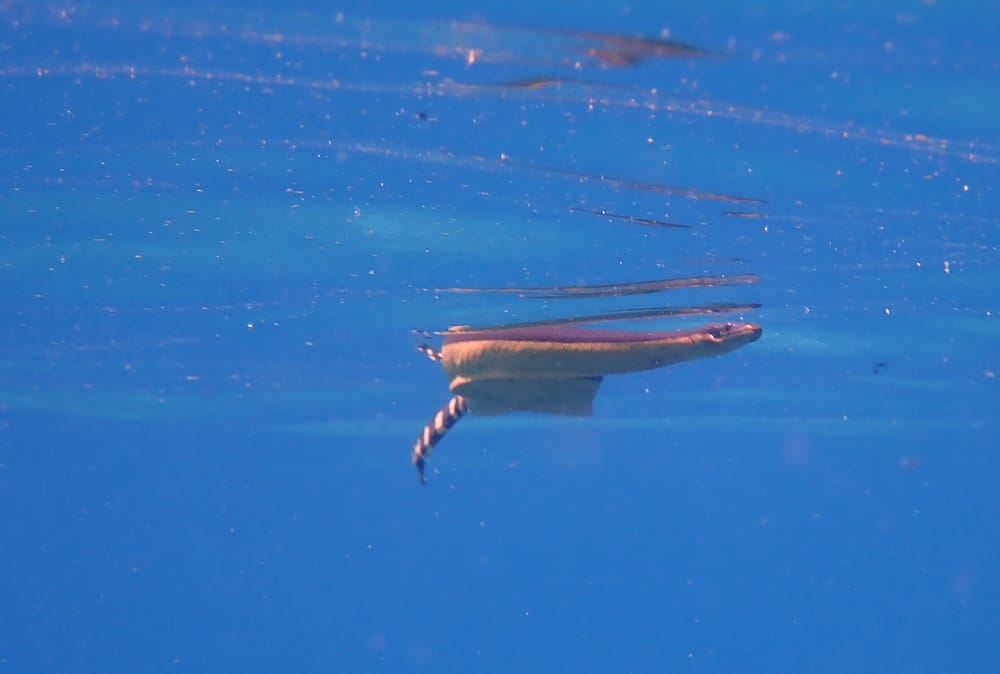
Within the open ocean, the most common places to spot yellow-bellied sea snakes are slicks. These are where ocean currents converge, dragging in a combination of vegetation debris, foam and scum. With shelter from sunlight, these slicks (which look pale from above) are home to mini ecosystems of small fish and plankton, which attract many curious yellow-bellied sea snakes in their wake. Ocean slicks can be as small as 10 metres or as long as several kilometres, and it’s possible to find thousands of Hydrophis platura congregating in a small area.
Stories of mass gatherings are quite common. In 1932, naturalist Willoughby Lowe followed an ocean slick in his ship that lasted for 60 miles, located between Sumatra and peninsular Malaysia. Yellow-bellied sea snakes were a constant presence, and he estimated the slick’s total population to have been in the millions.
Golfo de Papagayo, Costa Rica is another area where yellow-bellied sea snakes are plentiful. On December 3rd 2012, sailing scientists managed to find 1029 on a single slick within an hour.
Yellow-bellied sea snakes will feed on fish in these mass gatherings near slicks, but not mate. They’re clearly hard-nosed, survival-oriented gatherings rather than cosy gettogethers. Some believe that the ocean currents which created the slicks sometimes bring many yellow-bellied sea snakes together accidentally.
| 5 | A fine-tuned oxygen machine |
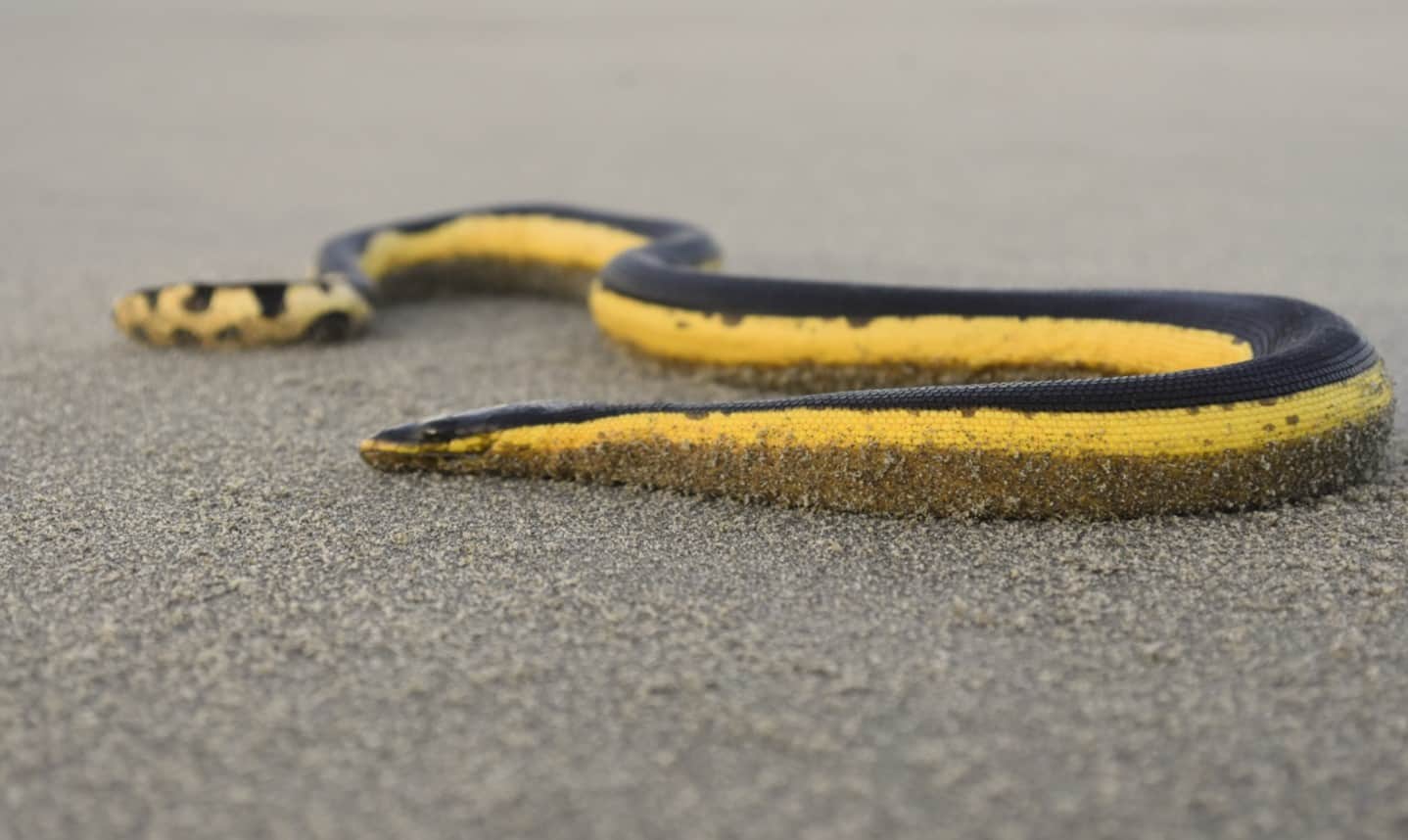
Yellow-bellied sea snakes must breathe, but can stay submerged for an extremely long time. Their average dive lasts for 1.5 to 3.5 hours, and they can spend 24 hours underwater without surfacing for oxygen. Compare this to the northern watersnake, which is respected by its snake pals in Ohio’s rivers for being able to submerge for 15 minutes.
One reason is their aquatic-adapted skin, which can absorb oxygen pockets underwater. This can account for 33% of their total oxygen supply. Their skin also processes and removes carbon dioxide. Some methods are more basic: the yellow-bellied sea snake has extremely large, elongated lungs. These not only give them a huge stash of air underwater, but keep them buoyant on the stormy sea surface.
The yellow-bellied sea snake’s lungs make up 11.8% of their body weight, one of the highest figures for any animal. Only a couple of sea turtles compare, including the mata mata turtle at 15%, and the pond slider turtle at 10-12%. These turtles have more of an excuse, as they need buoyancy to counteract their heavy shells, so that makes the yellow-bellied sea snake’s lungs all the more extreme. Yellow-bellied sea snakes are so buoyant that their upper body sometimes bursts out of the ocean surface like a life raft.
| 6 | Dehydrated for most of its life |
Despite their adaptions, yellow-bellied sea snakes aren’t invincible in the sea. They face the same truths as any animal – they get dehydrated, and this time they have to drink freshwater rather than salt.
Living in the open ocean, this would be impossible to come by for a human. The yellow-bellied sea snake’s strategy is to wait for heavy rains, belting down in lashing torrents which form pockets of freshwater on the ocean’s surface. Hydrophis platurus has ultra-sharp sensors for these pools (known as freshwater lenses), which they then drink from to replenish their stocks, before submerging into the depths.
Yellow-bellied sea snakes are able to lose 18.3% of their body mass due to dehydration before drinking becomes necessary. This is twice as high as the banded krait. Hydrophis platurus is a more evolved sea snake, walking further and further down the road to aquatic life, even if they’re not quite there yet. They’re also able to drink brackish (semi-salty) water, though fresh is preferred. They can drink water with a 50% salt content, versus just 30% for banded sea kraits and other Laticauda (sea krait) members.
| 7 | The furthest reaching sea snake |
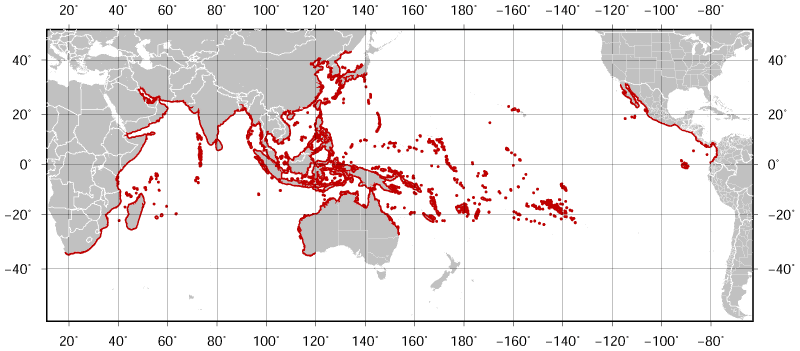
The yellow-bellied sea snake is also the only species to have been found in the Atlantic ocean, specifically off the west coast of Namibia, just around the corner from South Africa. This foothold is as far as they go into the Atlantic, for several reasons. Firstly, Namibia’s coast is extremely dry, and despite coping with salt water, yellow-bellied sea snakes still need freshwater to drink, licked up from pockets on the ocean surface.
Secondly, a cold water current called the Benguela Current begins just off the coast of Namibia. This is an upswelling of colder water from the ocean’s depths, which flows in a northerly direction along the African coastline for many hundreds of miles. The Benguela current’s average surface temperatures are 13-18C, while the minimum floor for yellow-bellied sea snakes is 16-18C. This cold current would drag them to a certain death. It has existed for at least 5 million years, so the barriers to colonising the Atlantic have long been in place.
Consequently, Namibia is the last stop for Hydrophis platurus. Nevertheless, no other sea snake has strayed this far from its Pacific origins.
| 8 | Lures fish to the surface |
Yellow-bellied sea snakes are a fish-eating snake, without being fussy about the exact species. In captivity, they eat live or dead fish, and also frogs, despite not having been in contact with them for millions of years.
Despite their far-flung ocean ways, yellow-bellied sea snakes prefer to hunt at the surface rather than probing along the floor. With their huge lungs providing buoyancy, they wait in surface slicks rich with schools of plankton and young fish, which block out sunlight. They wait patiently while the shadows attract small fish hoping to shelter from the warmth. Then the yellow-bellied sea snake strikes downwards with a sideways move of its head, grabbing the fish in its jaws, and sometimes swallowing without bothering to inject venom. Hydrophis platuras can also swim backwards, moving behind fish smoothly and confidently, so that their jaws are in the optimal position to grab them.
With poor eyesight, they prefer to sense water movements. As they pick up an oncoming fish, yellow-bellied sea snakes move their heads imperceptibly into their line of travel, keeping the rest of their body still.
| 9 | Venom facts |
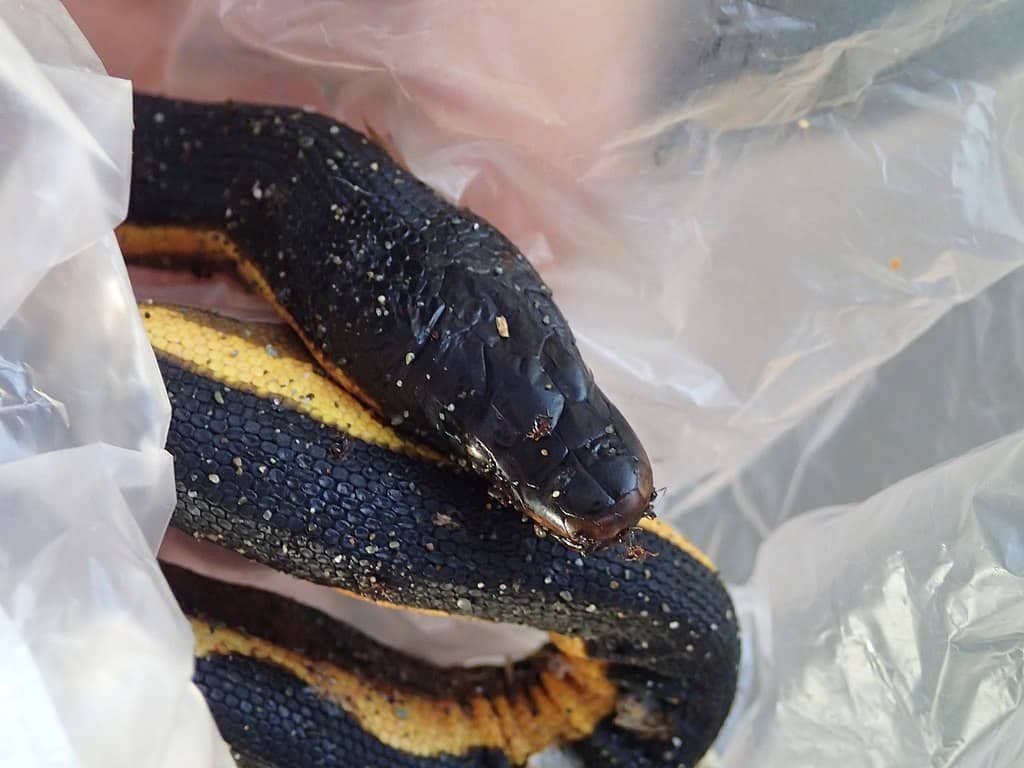
Hydrophis platurus is believed to have an extremely potent venom which specialises in neurotoxins, delivering muscle pain, stiffness, drowsiness and even paralysis. The LD50 score is supposedly 0.067mg, far stronger than a banded sea krait at 0.4mg and well outstripping a king cobra. A small number of fishermen have died after accidentally scooping them up in trawlers. Yellow-bellied sea snakes have a particular tendency to lock onto nets with their teeth. The mortality rate when untreated with antivenom is estimated at 10%.
Nevertheless, there’s signs that they’re far less dangerous than once believed. As reported in 2021, a 12 year old boy was relaxing in the waters of a beach in Costa Rica, enjoying a day out. Suddenly, he was bitten on the forearm by a floating black and yellow snake, which swam away calmly. Pain and swelling kicked in almost immediately, followed shortly after by tingling in the entire forearm (paraesthesia). But 6 hours later, from a secure hospital bed, his symptoms had died down, and there wasn’t a hint of the expected muscle weakness and paralysis.
Likewise, a confirmed yellow-bellied sea snake bite happened on a beach in Costa Rica in 1993, during high tide. This resulted in swelling, stiffness, discolouration and pain, but no life-threatening symptoms. The jury is out on the yellow-bellied sea snake’s danger levels.
| 10 | Nemesis: dolphins |
However unlikely, there’s a chance that you too could ride an enormous wave, walk back up the beach still buzzing with adrenaline, only to spot a yellow-bellied sea snake clinging to your surfboard. If so, there’s little to fear, given how immobile they are on land, but you should avoid touching them at all costs, as this can trigger their bite instinct even if they’re slowly dying. The counterbalance is the small venom quantities they inject, and a small mouth which makes injecting venom difficulty.
Yellow-bellied snakes have a surprising enemy: dolphins. Bottlenose dolphins living in San Diego bay have been observed eating them, including one dolphin which swallowed 8 snakes in a meal. It approached the Hydrophis platurus making clicking sounds then rapidly slurped it down, with the tail finally disappearing into its mouth. Then it started making loud dolphin squealing sounds. A larger yellow-bellied sea snake managed to flee.
